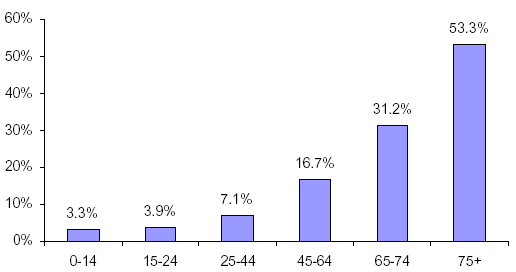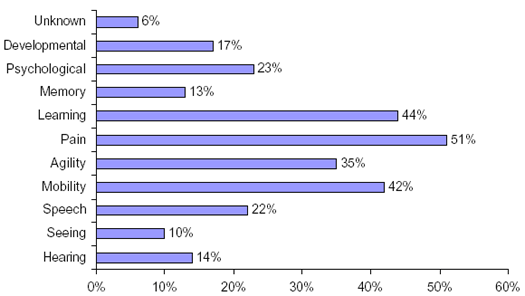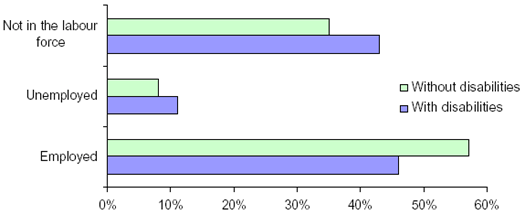
Section 9. Disability
Disability, as defined for the purposes of the Participation and Activity Limitation Survey (PALS)1, refers to difficulties with daily activities and the reduction in the amount or kind of activities due to physical or mental conditions or health problems. The PALS is conducted by Statistics Canada, as a supplement to the census, and thus the latest data is from 2001. This section on youth disability has been principally sourced from the publication of the results of the PALS, A Profile of Disability in Canada, 20012.
In 2001, 12% of Canadians reported having a disability. The PALS confirms that the disability rate gradually increases with age. Among children aged 0 to 14 the disability rate3 was 3% and rose to nearly 10% among adults aged 15 to 64 and climbed to more than 40% among persons aged 65 and over. More than half (53%) of persons aged 75 and over report having a disability. Within the population aged 15 to 64, this gradual increase is reflected in a rate of about 4% among young adults 15 to 24 years of age, compared to 7% among persons aged 25 to 44 and 17% among those aged 45 to 64. Figure 9.1 shows the percentage of population with disabilities by age.
Figure 9-1: Disability Rate by Age, 2001

Please note that Yukon, Northwest Territories and Nunavut are excluded.
Source: Statistics Canada, Participation and Activity Limitation Survey, 2001 found in A Profile of Disability in Canada, 2001. Catalogue No.:89-577-XIE
Of the total working age population with disabilities, 151,030 were youths between the ages of 15-24. Of this population, 74,500 were male and 76,530 were female. The majority of these youths (69%) had mild to moderate disabilities, 20% had severe disabilities and 11% had very severe disabilities4. Among youths with disabilities, 33% had one disability, 20% had two and 47% have three or more.
9.1 Forms of Disability
Pain-related disability increases gradually from age 15 to 64, and while the proportion of young adults reporting pain-related disability was small, the type of limitation was reported by more than half (51%) of young adults aged 15 to 24 with disabilities5. The gap between the sexes was also more pronounced in this age group, young women with disabilities being much more likely to have pain-related limitations (59%) than young men (43%). Also, the rate of developmental disabilities was higher for youth than for the rest of the working age population, with 17% of youths reporting them. As well, 23% of youths with disabilities had psychological disabilities.
Figure 9-2: Disability by Type for Youth 15 to 24, 2001

Please note that Yukon, Northwest Territories and Nunavut are excluded.
Source: Statistics Canada, Participation and Activity Limitation Survey, 2001 found in A Profile of Disability in Canada, 2001. Catalogue No.:89-577-XIE
9.2 Education and Disabled Youth
Approximately 48% of youths with disabilities were full-time students6. A greater proportion of youths with disabilities had less than a high school education than did their counterparts without disabilities (51% compared to 42%). This figure suggested that youths with disabilities took longer or had more difficulty completing high school. After high school, youths with disabilities, were somewhat less likely to complete post-secondary education than youths without disabilities. The difference ranged from a nearly equal likelihood of completing a trade certificate (4.2% compared to 4.6%) to a less than half likelihood of completing university (3% compared to 7%).
Figure 9-3: Educational Attainment for Youth (15-24) With and Without Disabilities, 2001

Please note that Yukon, Northwest Territories and Nunavut are excluded.
Source: Statistics Canada, Participation and Activity Limitation Survey, 2001 found in A Profile of Disability in Canada, 2001. Catalogue No.:89-577-XIE
9.3 Employment and Disabled Youth
Labour force participation statistics show that youths with disabilities face challenges in making the transition from school to the labour market7. The difficulties faced by youths with disabilities in the transition to employment are apparent in the labour force participation rates of youth no longer in school. Among youths with disabilities, 53% who were out of school were employed and 14% were unemployed. In contrast, among youths without disabilities who were no longer students, 72% were employed and 9% were unemployed.
About 46% of youths with disabilities were employed, compared to 57% of youths without disabilities. Youths with disabilities were more likely to be unemployed than youths without disabilities (11% compared to 9%). About 43% of youths with disabilities were not in the labour force, compared to 35% of youths without disabilities. However, many youths in this age category were in school and therefore were less likely to be available for work.
Figure 9-4: Labour Force Activity for Youth (15-24) With and Without Disabilities, 2001

Please note that Yukon, Northwest Territories and Nunavut are excluded.
Source: Statistics Canada, Participation and Activity Limitation Survey, 2001 found in A Profile of Disability in Canada, 2001. Catalogue No.:89-577-XIE
1 The 2001 Participation and Activity Limitation Survey (PALS) is a post-censal survey of adults and children whose everyday activities may be limited because of a condition or health problem. A sample of those persons who answered 'Yes' to the 2001 Census disability filter questions were included in the PALS Survey population.
2 This section has been sourced mostly from Statistics Canada: A Profile of Disability in Canada, 2001 unless otherwise stated. Available: http://www.statcan.ca/english/freepub/89-577-XIE/pdf/89-577-XIE01001.pdf.
3 The disability rate refers to the total number of persons who reported activity limitations expressed as a percentage of the population.
4 An index measuring the severity of the disability was constructed based on the answers to the survey questions. Points were given according to the intensity and frequency of the activity limitations reported by the respondent. A single score was computed for each type of disability.
5 This section has been sourced mostly from Statistics Canada: A Profile of Disability in Canada, 2001 unless otherwise stated. Available: http://www.statcan.ca/english/freepub/89-577-XIE/pdf/89-577-XIE01001.pdf.
6 This section has been sourced mostly from Statistics Canada: A Profile of Disability in Canada, 2001 unless otherwise stated. Available: http://www.statcan.ca/english/freepub/89-577-XIE/pdf/89-577-XIE01001.pdf.
7 This section has been sourced mostly from Statistics Canada: A Profile of Disability in Canada, 2001 unless otherwise stated. Available: http://www.statcan.ca/english/freepub/89-577-XIE/pdf/89-577-XIE01001.pdf.
|

